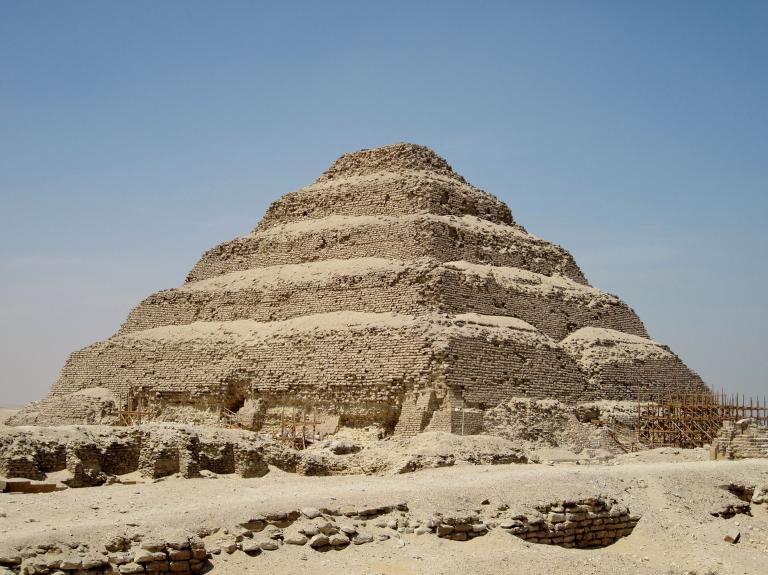
The capital of the ancient Egyptian Old Kingdom was in Memphis, to the south of the modern city of Cairo, which was only founded in AD 969.
Relatively little is left of Memphis today. The Egyptians were acutely aware of the transience of mortal life, and they seem to have been much more concerned to build permanent buildings in the necropolis areas that pertained to the capital city — Giza and Saqqara. Whereas Memphis was built on the eastern bank of the Nile, in the direction of the rising sun, the great pyramids and other tombs at Saqqara and at Giza were constructed on the Nile’s western bank, appropriately placed on the side of the river toward the sunset.
There are, however, still some fascinating things to be seen at Memphis (which is near the modern town of Mit Rahina), and tours that make any pretense of even approaching adequate coverage of Egyptian antiquities in the vicinity of Cairo typically make a stop there. (Ours always do, for example.) The single most striking object there is an enormous stone statue of Ramses II (aka, as he himself would likely have insisted, Ramses the Great).
I can’t visit Memphis without thinking of an episode that happened during an earlier visit there, many years ago.
My wife and I were wandering about the site — with, I think, an Egyptian friend of ours — when I noticed a group of Swiss tourists listening with rapt attention to a German-speaking tour guide. I always pay attention to Swiss tourists, and I enjoy occasionally listening in on German-language lectures. So I pulled in for a few minutes by this group.
Very soon, I was in a moral dilemma.
The tour guide was explaining to his obviously very trusting audience that, contrary to what they had been taught, only two of the ancient kings of Egypt had ever actually borne the title of pharaoh, which, he said, was granted to them because they were such outstanding rulers. And who were the two magnificent kings who had been singled out for this exceptional honor? They were Tutankhamun and Ramses II.
Now, Ramses II would have liked this explanation, even though it was complete nonsense. He’s the guy who went around chiseling the names of his predecessors off of their statues and replacing their names with his own. He had eight Great Royal Wives, a large number of concubines, and somewhere between eighty-eight and one hundred and three children. He came to the throne of Egypt at the age of roughly twenty-four and reigned for approximately sixty-six years, from at least BC 1279 to BC 1213. (I wonder if it ever bothered him that the years were actually going down or backward in his day?) In fact, his father, the great Seti I, may have appointed him prince regent already at the age of fourteen, and he may actually have assumed sole control of Egypt while still in his teens, maintaining himself in power until his death at ninety or ninety-one.
But Tutankhamun? Really? Poor “King Tut” ruled for only about nine years, from BC 1332 to BC 1323, and died at the age of eighteen. He was far from the greatest of the monarchs of Egypt — as is shown by, among other things, the relatively tiny size of his tomb in the Valley of the Kings across the Nile from Luxor.
In any event, the assertion that the title of pharoah was given only to Ramses II and Tutankhamun is flat nonsense. I seriously considered intervening to correct what the guide was telling his innocent Swiss hearers. But I didn’t. And I’ve felt at least slightly guilty about that ever since.










